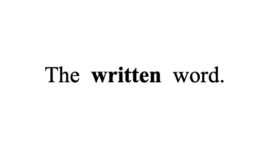The written word wants more from its reader, and in return provides more of its own essence. What is it to write? What does it mean to be a word?
How To Read

In some sense, a word is a collection of letters,
which themselves are understood as meaningful images.
A word can mean something,
but only to someone who understands that language.
And who even knows what a word really wants to say.
Words demand some sort of materialization,
some liberation
as an oral or written expression.
What is it to write?
Making marks on a surface,
illustrating a language. The action of it drags one material over or through another, either adding or subtracting the precise, peculiar, three-dimensional shapes of the characters.
Some characters, like those in the Latin alphabet, are phonetic, speech written down, while other characters are formal, developed with extreme attention to the visual minutiae that define the word.
To write is to create the alphabet in the tangible world, and not just the alphabet, but all the dots and slashes and curves that signify and construct the grammar and punctuation symbols, spaced out intentionally, evocatively in the most extreme sense.
Writing feels immortal, words feel immortal, even though their written form is not. All of this magic was based upon the tangibility of the written word, its presence in the world as truth, a movable set of images more officially sanctioned than any other by archival history.
 Writing by handheld instrument, be it a brush or a chisel or any other such thing, was in a sense holy; to master that kind of dexterity and precision made you a creator, a typification of God or at the very least a prophet. Even manual printing, a longstanding art and manufacturing medium, maintained the physical integrity of the written word by adhering to the same processes:
Writing by handheld instrument, be it a brush or a chisel or any other such thing, was in a sense holy; to master that kind of dexterity and precision made you a creator, a typification of God or at the very least a prophet. Even manual printing, a longstanding art and manufacturing medium, maintained the physical integrity of the written word by adhering to the same processes:
one surface
impresses itself upon
another surface,
stamping its mark into or onto that object
and forever redefining it.
The dissemination of the Gutenburg printing press across Europe and then the Western world expanded the social importance of the written word, enforcing the importance of its intellectual ownership by the name printed alongside it.
To ‘write’ something was to conjure an idea and also to circulate it, to wider and
wider audiences. Its innate holiness and the necessary agency of its creation remained
central to writing while shifting them from a more tangible basis to a conceptual one.
What is a word? What is it to write, really?
Will we ever pierce through this veil of ambiguity?

Intrinsically, inevitably, writing was importantly physical. The materiality of writing may just be the source of its power, separating the written word from spoken and granting it a permanent presence, distinct from its speaker,
and certainly less temporary.
The feeling of using a typewriter marries these two creator types, translating your own ideas into a decipherable visual artifact with each progressive drum of the stamped character upon the paper.
Even the HP printer in my childhood home functioned with very many odd rollers and stamps and (very expensive) ink, as I found out when I tried to take it apart.
Words, I knew then from my elementary school classes, were mostly meant to be put onto something. Even the projector’s light painted them, for a moment, onto a tangible thing (the wall, the cloth screen, or onto the roundness of your own body), and the shapes on our TV were made from the tiny lightbulbs that you could only see if you got so close to the screen that your head began to hurt .
These processes of placing words in the physical world —
were they all still writing? Is the .jpg image of the text on a billboard which I downloaded off Twitter still
‘the written word’?
What is it to write? To sit in front of a glowing collection of lights and to punch little buttons, constructing words and ideas, tracing their lineage through so many different
writers,
mediums,
Messages.
The written word, and its fashionable appearance. It hardly seems like we’re doing the same thing, but the visual language remains recognizable. Lines and shapes against a background, hopefully legible, hopefully meaningful. Formed with the knowledge of its own limits, easily immortalized on temporary surfaces, but proclaimed nonetheless.
Does a sentence drawn by hand know how exactly or essentially it can be copied? Should a digital sentence know about the hand-written others, and be allowed to wonder how it stacks up? Do either of them know how easily they are tossed away and forgotten?
The written word wants more from its reader, and in return provides more of its essence.

It must be happy in its ambiguity.